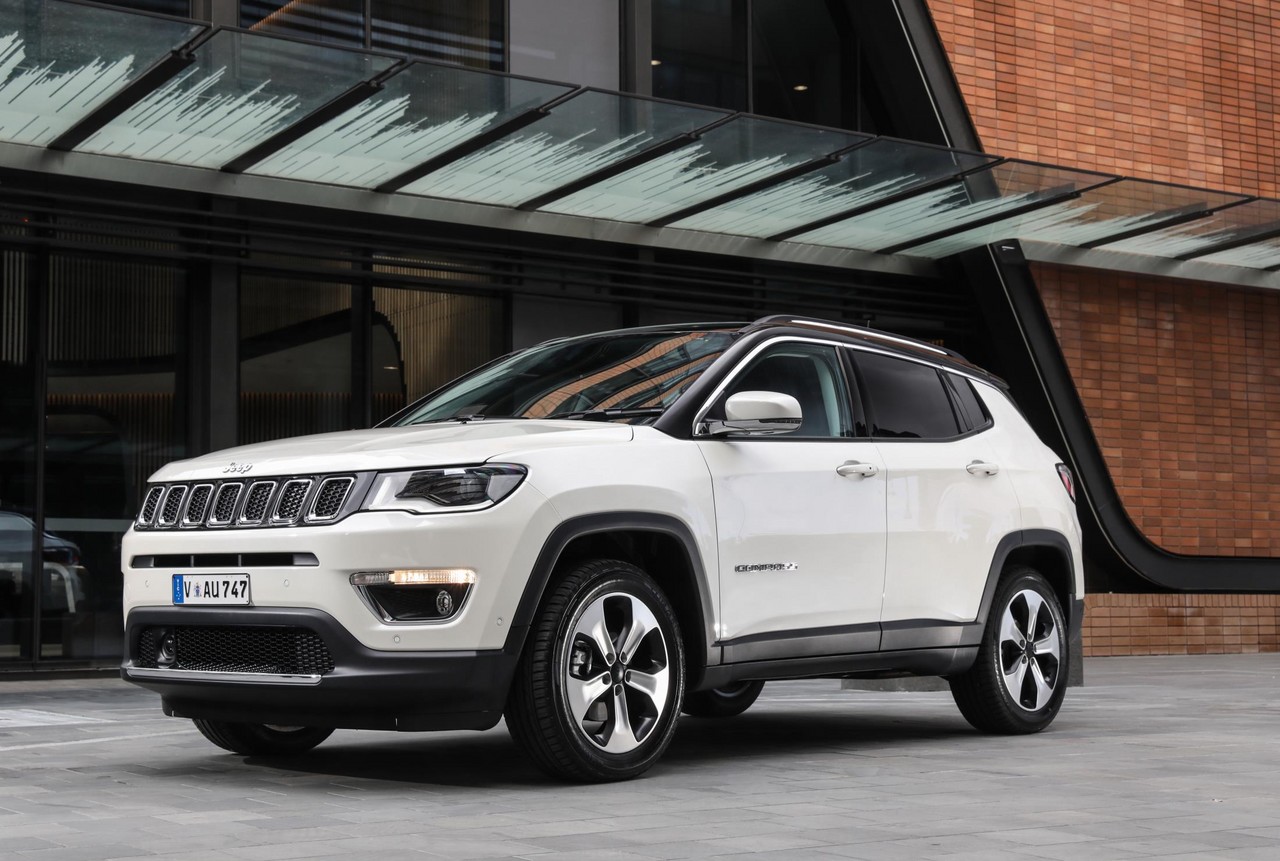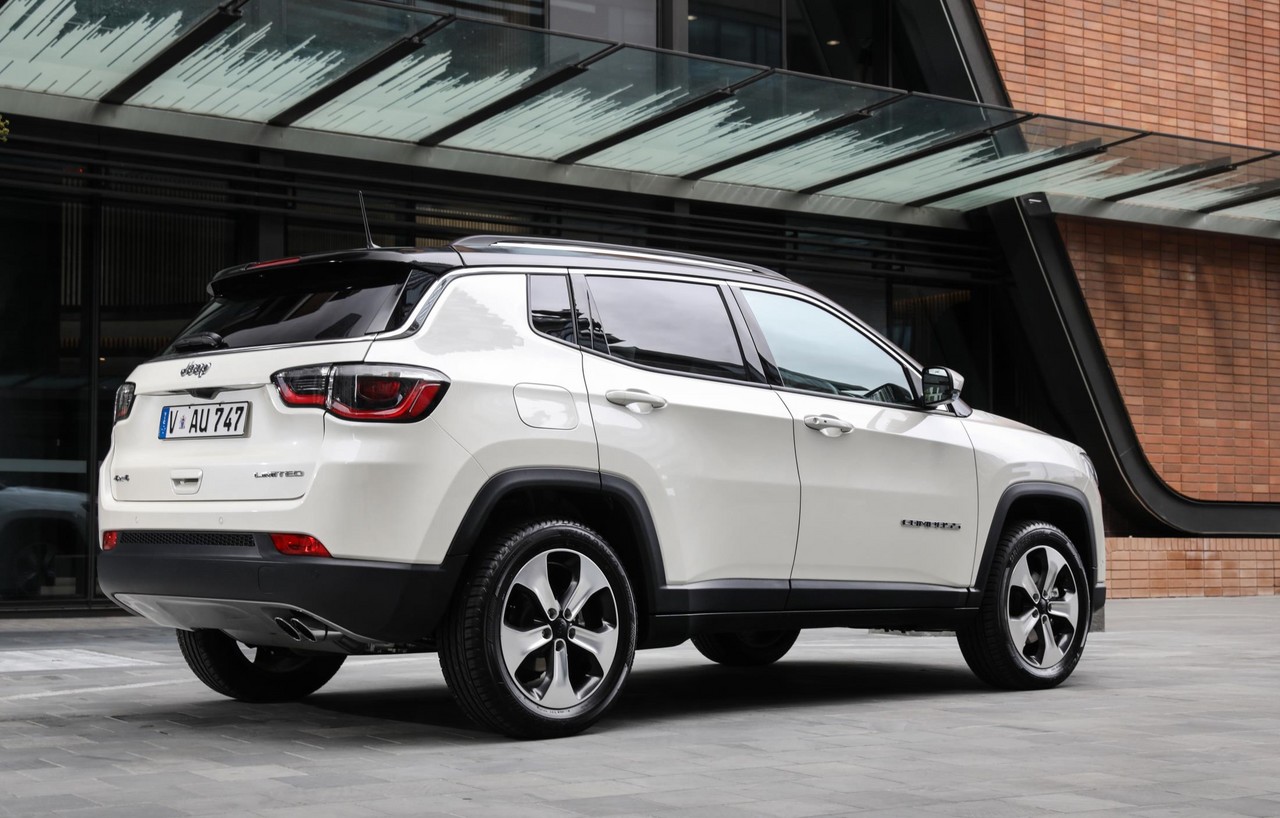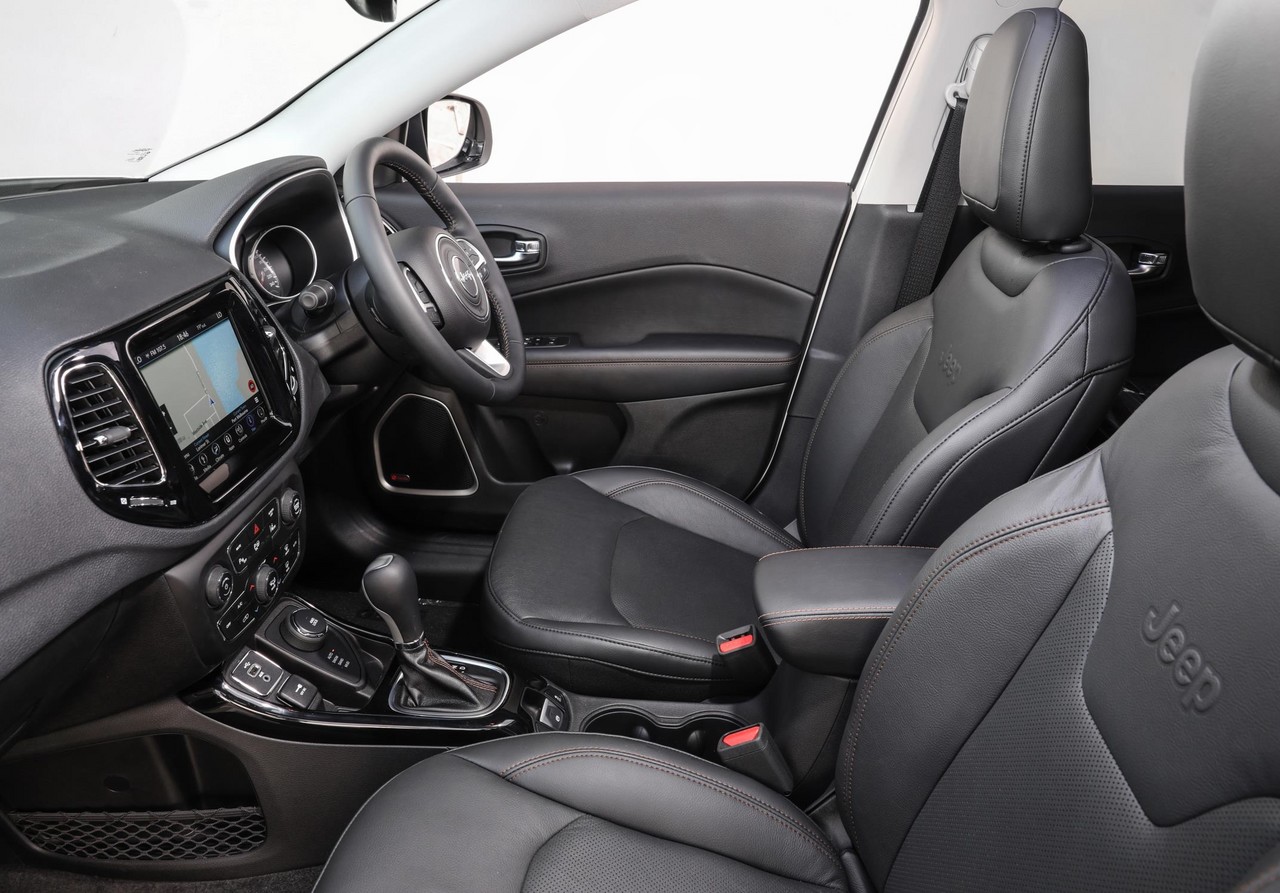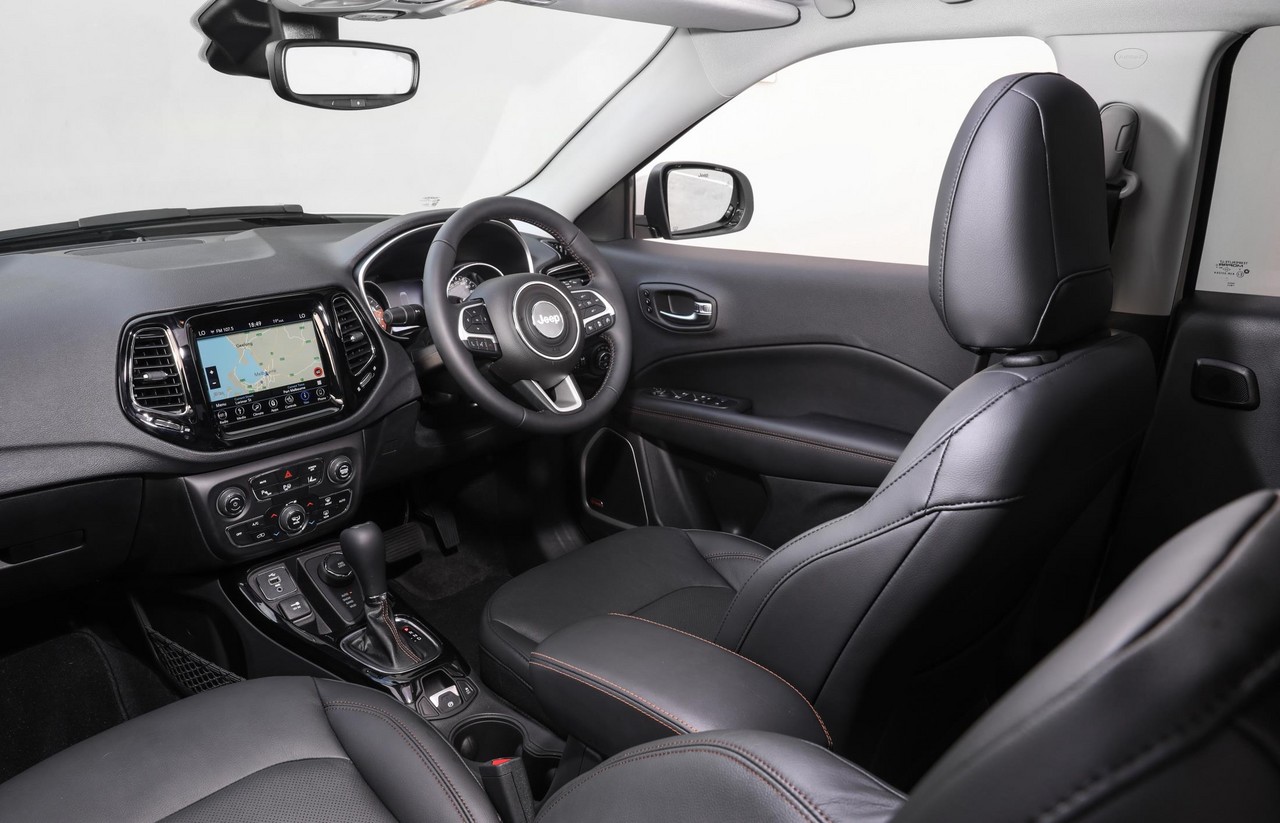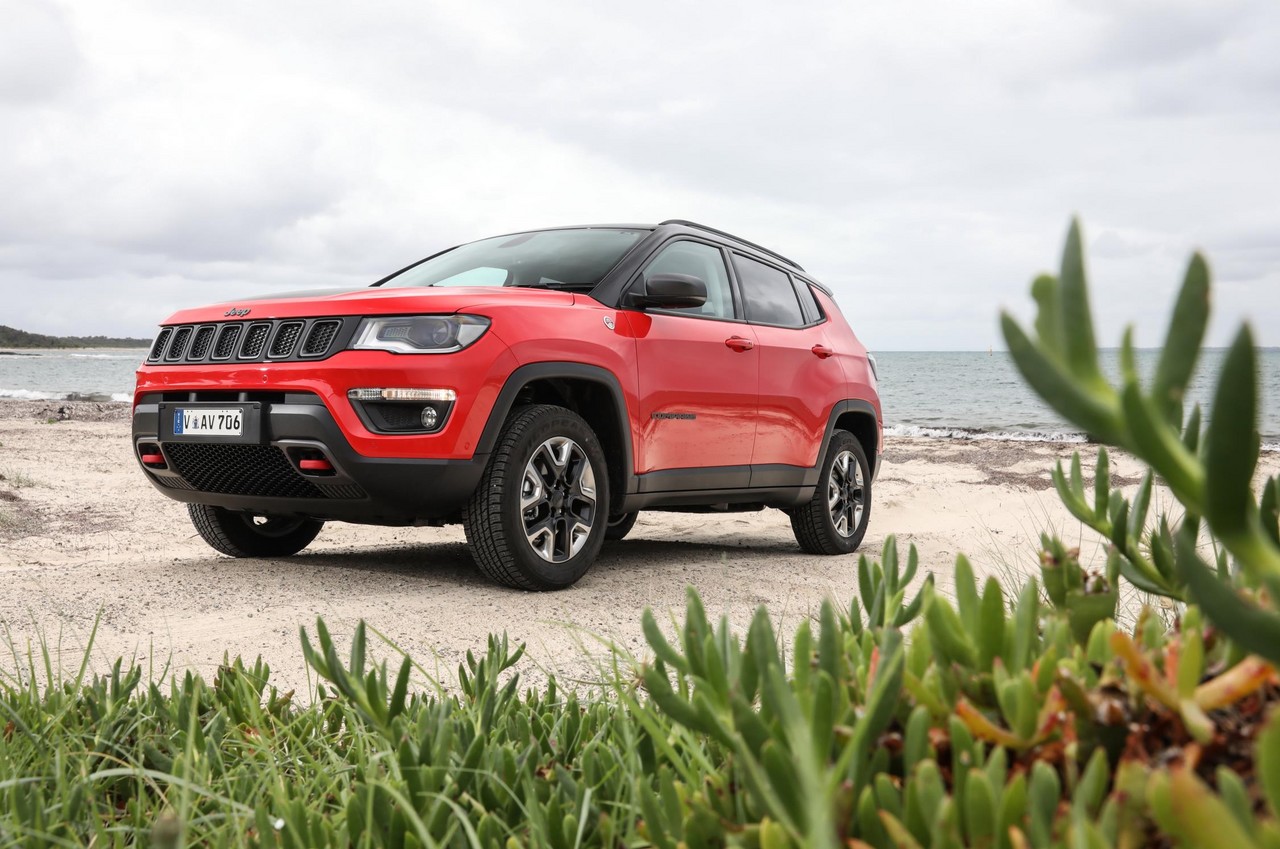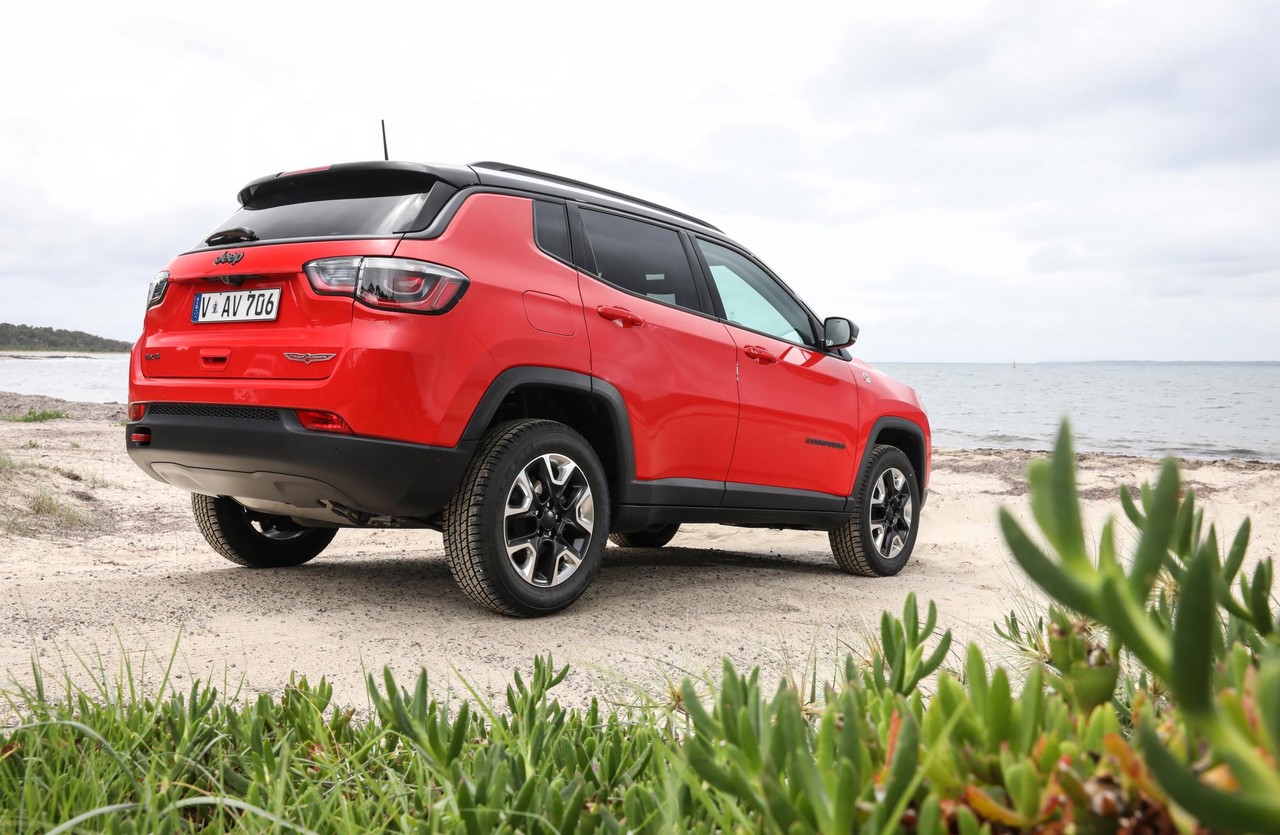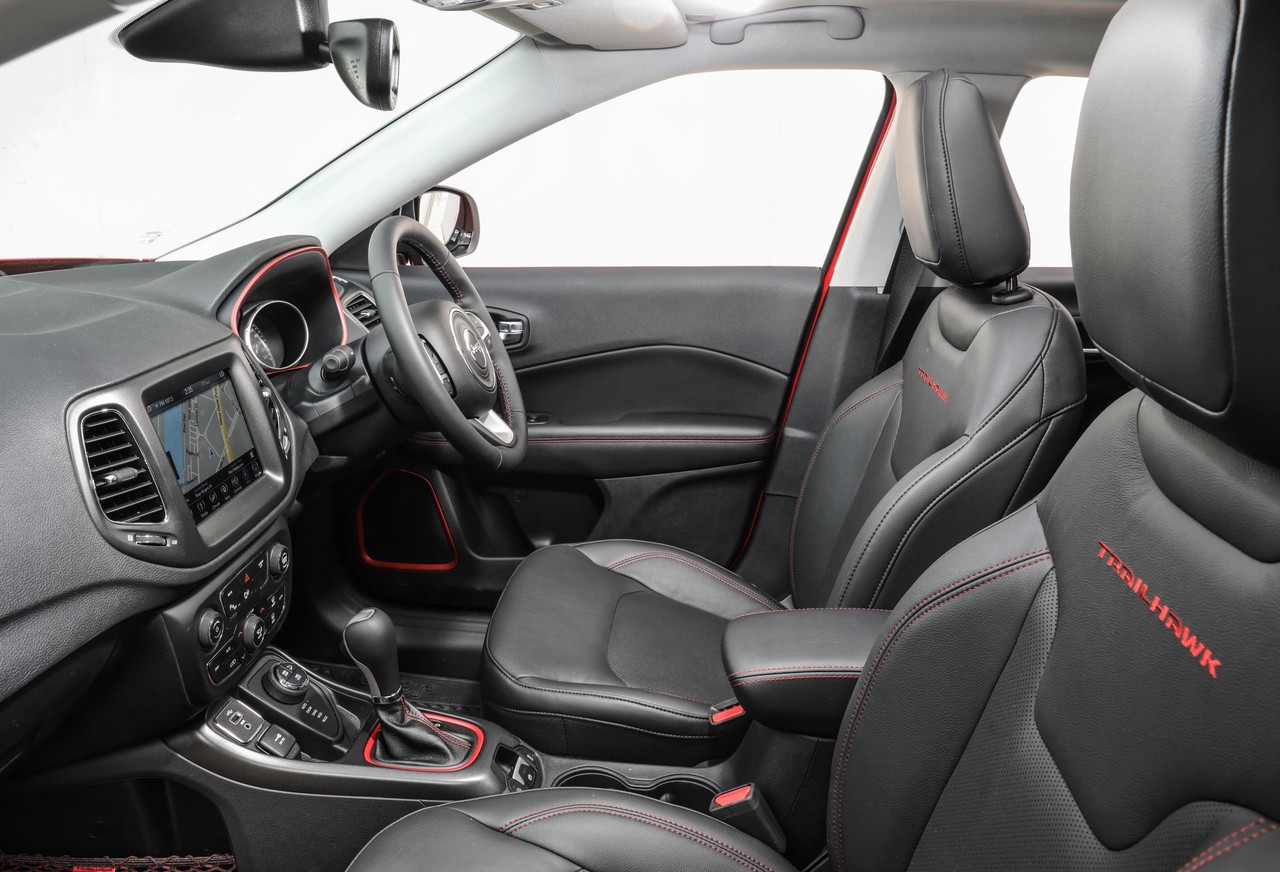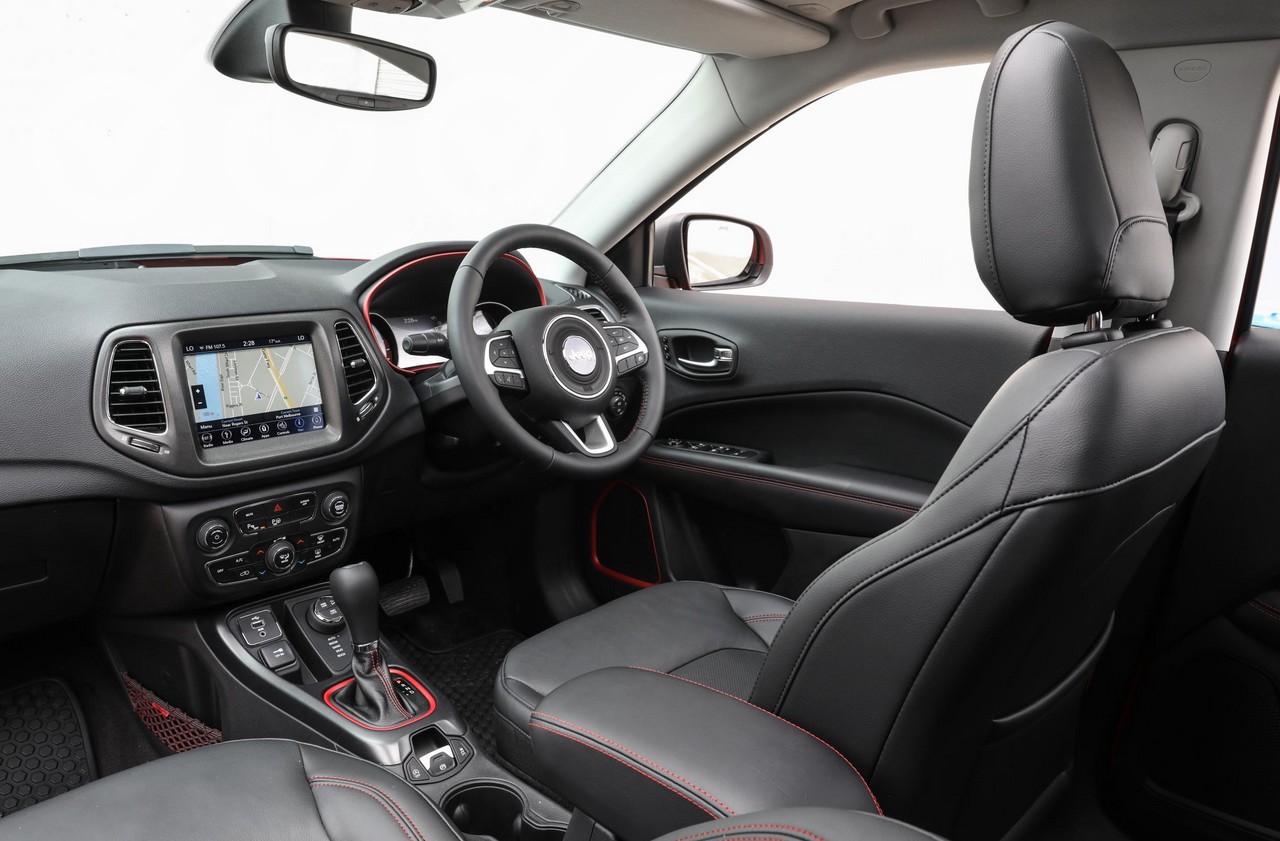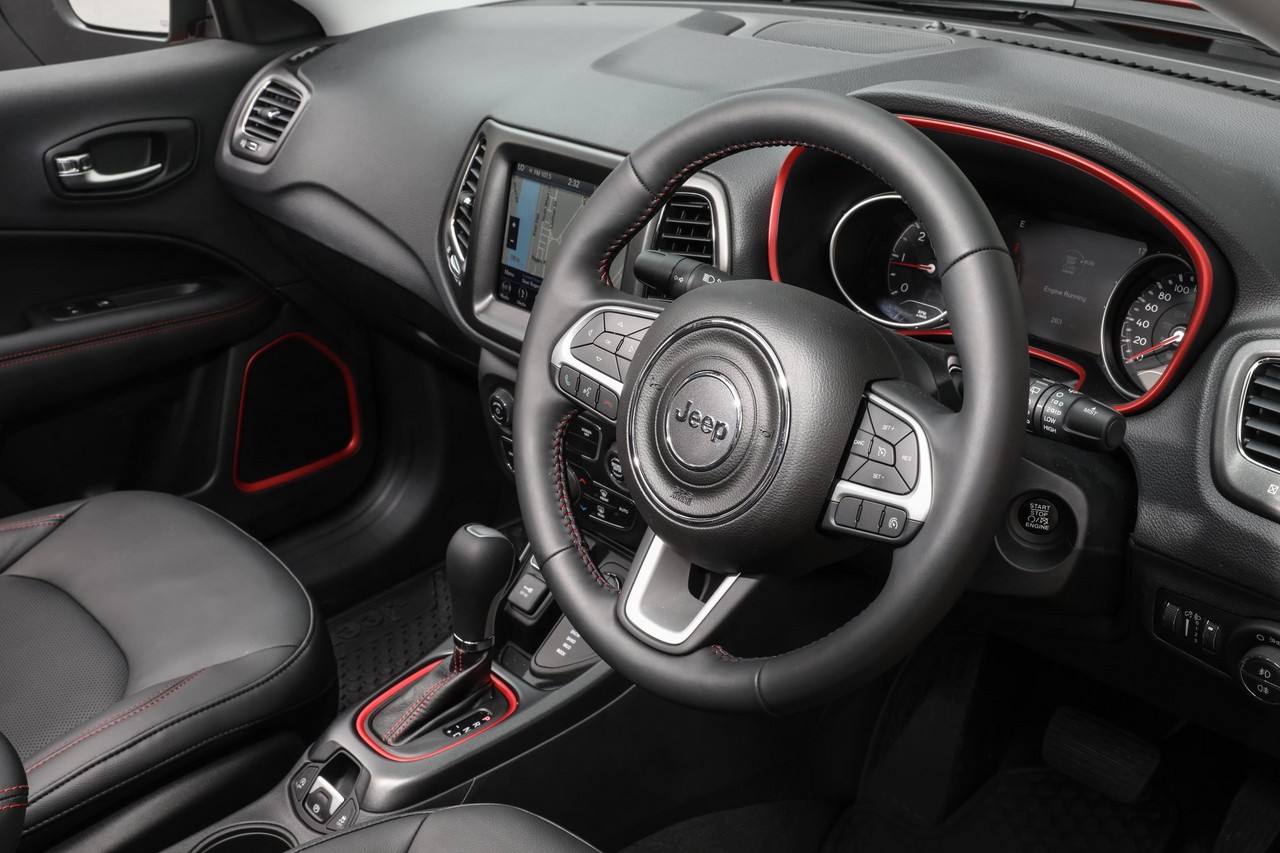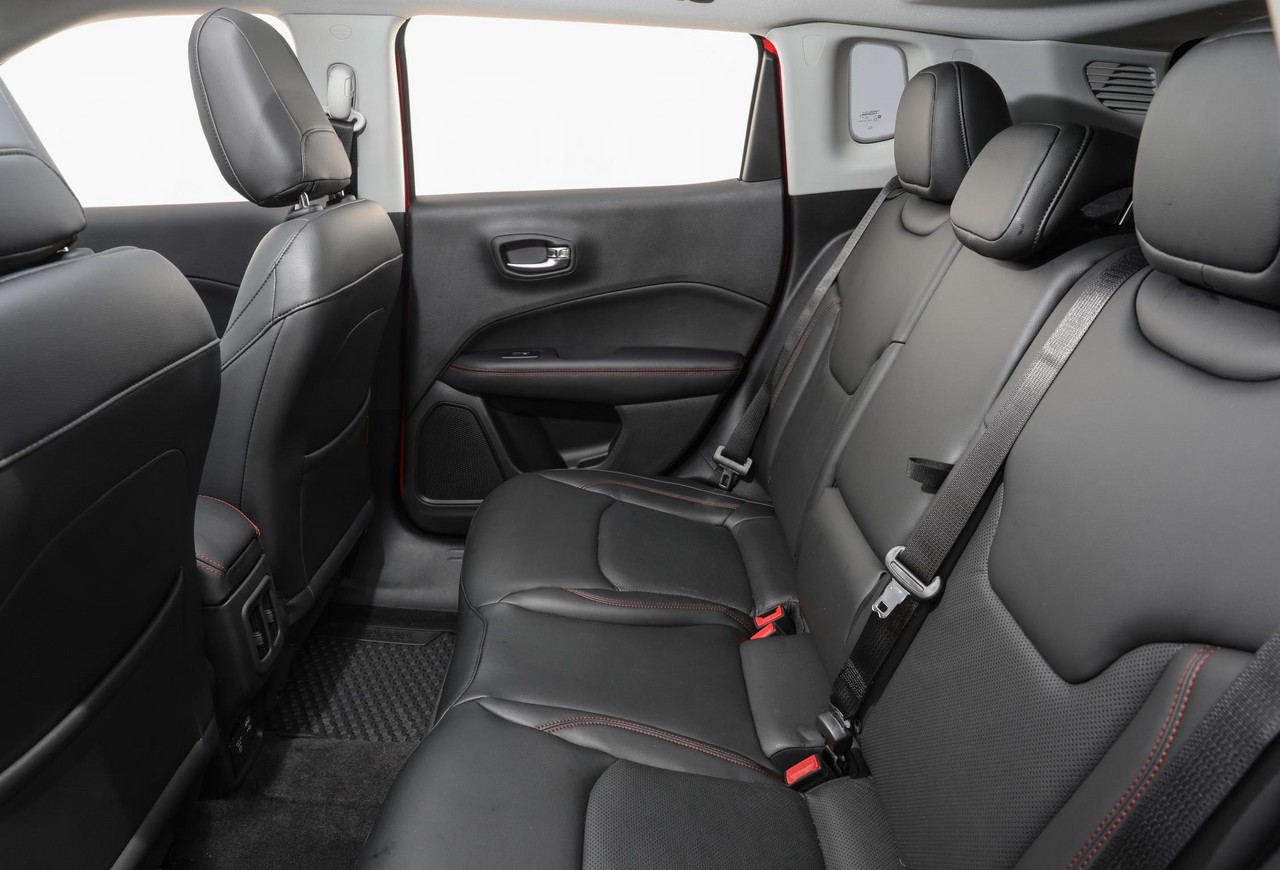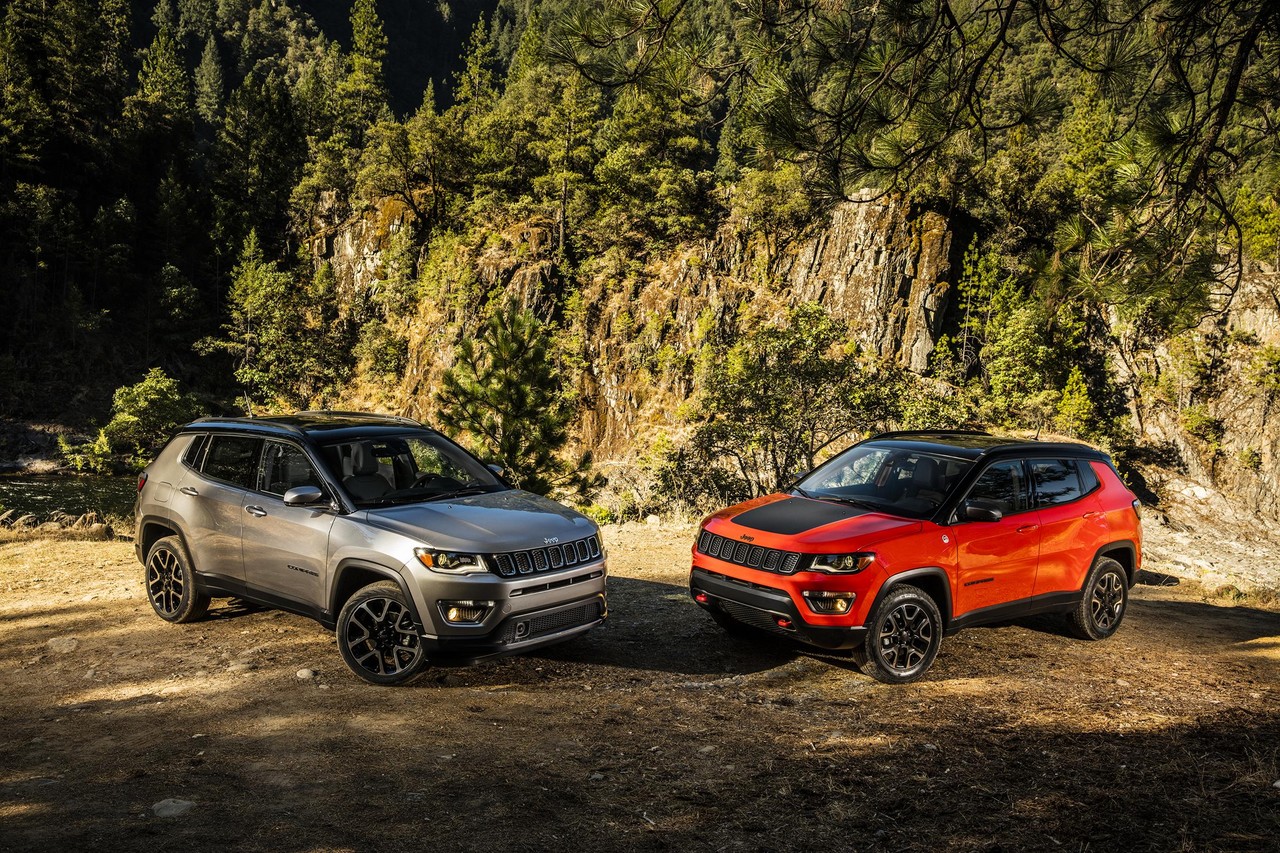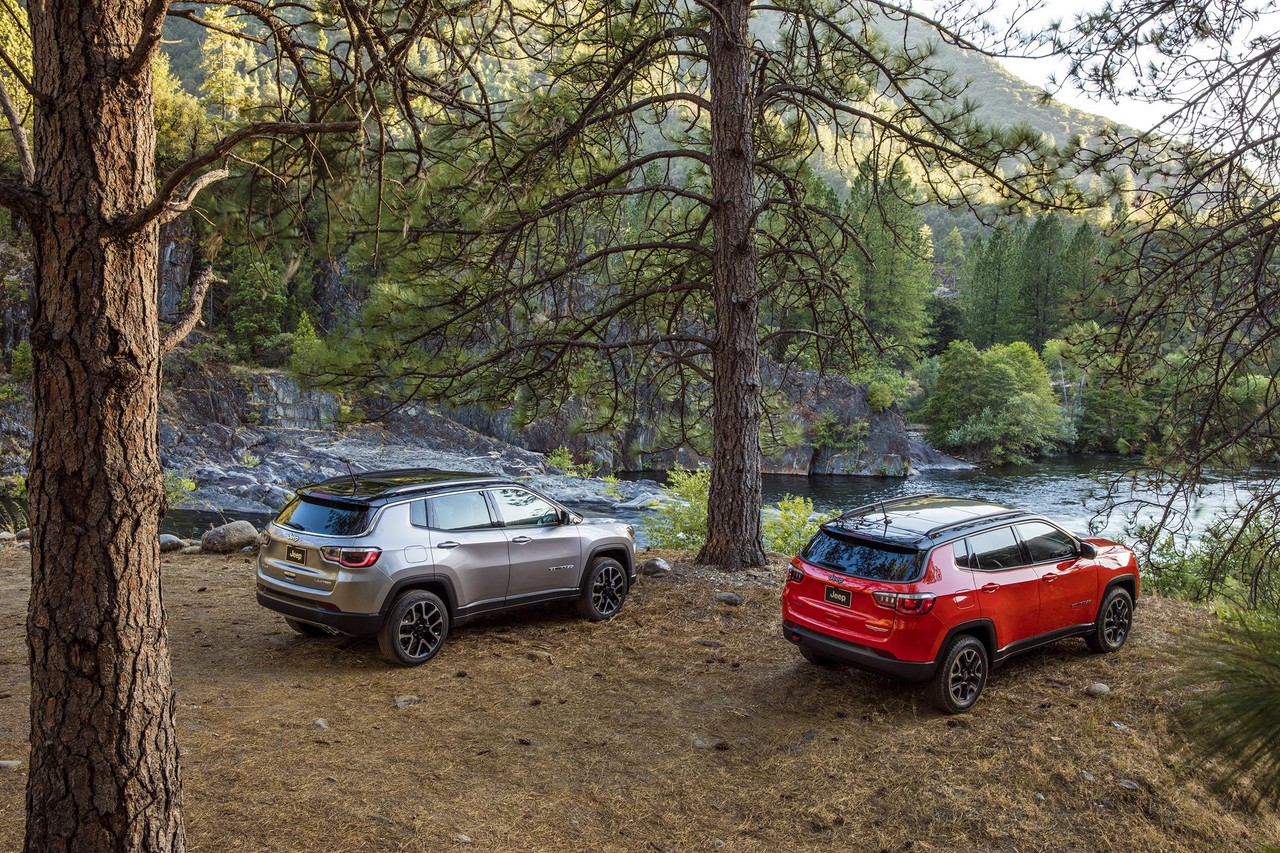
- ‘Small wide 4×4 architecture’ bodes well for ride comfort and interior space
- Off-road capability of Compass Trailhawk
- Availability of active safety technologies
- Styling differentiates it from the similar buy smaller Jeep Renegade
- Autonomous Emergency Braking (AEB) only available as an extra-cost option
- Doubts over build quality
- Tyre noise on coarse chip roads?
Overview
Released in Australia in December 2017, the Jeep M6 Compass was a compact SUV. Manufactured in Ranjangaon, India, the Jeep M6 Compass was powered by 2.0-litre turbo diesel and 2.4-litre petrol engines, and available in Sport, Longitude, Limited and Trailhawk editions.
| Variant | Engine | Drive | Edition | Trans. | Peak power | Peak torque |
|---|---|---|---|---|---|---|
| 2.4 Tiger shark | 2359 cc petrol I4 | FWD | Sport | 6sp man. | 129 kW at 6400 rpm | 229 Nm at 3900 rpm |
| Sport, Longi-tude |
6sp auto | |||||
| AWD | Limited | 9sp auto | ||||
| 2.0 MultiJet II (Stop & Start) |
1956 cc turbo diesel I4 | AWD | Limited, Trail-hawk |
9sp auto | 125 kW at 3750 rpm | 350 Nm at 1750 rpm |
‘Jeep Active Drive’ all-wheel drive system
AustralianCar.Reviews understands that the ‘Jeep Active Drive’ all-wheel drive system had a power transfer unit (PTU) that was positioned ahead of the rear axle differential and which housed a fully variable wet clutch. In the ‘Auto’ drive mode, the rear axle could disconnect such that the Jeep Compass was front-wheel drive only. The ‘Jeep Active Drive’ system, however, used inputs from sensors to determine if the clutch should be engaged to direct torque to the rear axle for 1) yaw correction and 2) to correct under- or over-steer. Furthermore, the system had a ‘Lock’ function which could provide permanent four-wheel drive.
The Jeep Active Drive system also included:
- A Brake Lock Differential System (BLDS) which allowed the Jeep Compass to maintain forward motion if one or two wheels lost traction by selectively and aggressively applying brakes to the spinning wheels; and,
- A Brake Traction Control System (BTCS) which sought to prevent the driving wheels from spinning during acceleration from a stop or during slow speeds by applying individual brakes to the slipping wheel(s).
Jeep Compass Trailhawk: Active Drive Low and off-road capability
The ‘Jeep Active Drive Low’ all-wheel drive system extended the capability of the Jeep Active Drive System by having a 20:1 crawl ratio – based on a 4.71:1 first gear ratio and 4.334:1 final drive ratio – which enabled up to 2000 Nm to be directed to the rear axle. Unlike Jeep Active Drive, Jeep Active Drive Low did not have a rear axle disconnect capability.
Solely available with Jeep Active Drive Low, the Jeep Compass Trailhawk had the following attributes for greater off-road capability:
- A 25 mm higher ride height for ground clearance of 216 mm;
- Unique fascias for a 30-degree approach angle, 24.4-degree breakover angle and a 33.6-degree departure angle;
- Skid plates;
- Tow hooks;
- Jeep’s ‘Selec-Speed Control with Hill-descent Control’;
- 17-inch off-road tyres; and,
- A water fording depth of 480 mm.
Jeep Selec-Terrain system
For both all-wheel drive systems, the Jeep ‘Selec-Terrain’ traction management system enabled the driver to select from the following drive modes:
- Auto: provided automatic detection of the need for four-wheel drive and a continuously variable front:rear torque split;
- Snow: engaged second gear for accelerations from rest, ‘slick surface’ electronic brake controls and full-time all-wheel drive with a target front:rear torque split of up to 60:40;
- Sand/Mud: designed to provide enhanced control in off-road conditions, the Sand and Mud modes provided off-road electronic brake controls, full-time all-wheel drive and a variable torque split; and,
- Rock (solely available with Jeep Active Drive Low as fitted to the Compass Trailhawk): designed for use on obstacles, Rock mode provided off-road electronic brake controls with increased brake lock differential capacity and a fully variable torque split. Furthermore, Rock mode could only be engaged in conjunction with the low range gears (‘4-Low’) and disengaged the electronic stability control (ESC) system.
Body and dimensions
Like the Jeep BU Renegade , the Jeep M6 Compass was underpinned by Fiat Chrysler’s ‘small wide 4×4 architecture’. As such, the Jeep Compass had a monocoque chassis (i.e. the upper body structure and frame were combined) and more than 65 per cent of the body was made from high-strength steels. To reduce interior noise, the Jeep Compass has framed under glass door construction with triple seals and acoustic wheel-well liners.
Compared to the Jeep BU Renegade , the Jeep M6 Compass was 162 mm longer (at 4394 mm), 70 mm wider (1874 mm), 48 mm lower (1641 mm, without roof rails) and had a 66 mm longer wheelbase (2636 mm). Furthermore, the Jeep Compass had a ground clearance of 198 mm or 208 mm for the front- and all-wheel drive models, respectively.
Suspension
The Jeep M6 Compass had MacPherson strut front suspension with coil springs and a double shell lower control stabiliser bar. The front suspension included a flat front steel cross-member that improved rigidity and provided a third-load line for energy absorption in the event of a collision. For improved acoustics and better shock absorber efficiency, the Jeep Compass had ‘split’ type shock absorber mountings which transmitted road vibrations to the body structure through two different routes.
At the rear, the Jeep M6 Compass had Chapman suspension with two lateral links and half-shafts. For the rear suspension, high-mounted strut-type shock absorbers and coil springs were used to maximise spring rates and improve roll-steer characteristics. While all-wheel drive models had an isolated rear steel cradle, the cradle was not isolated for front-wheel drive models.
Both the front and rear suspension utilised Frequency Selective Damping (FSD) Koni shock absorbers that responded differently to low-frequency movement (such as cornering, braking and accelerating) and high frequency movement (such as driving on uneven roads). Furthermore, front and rear wheel articulation for the Jeep Compass was 170 mm and 208 mm, respectively.
Steering
The Jeep M6 Compass had rack-and-pinion steering with a column-mounted electric motor for power assistance that varied according to driving speed; its steering ratio was 15.7:1. The steering included Jeep’s ‘Driving Steering Torque’ (DST) system which provided corrections and automatically controlled over-steer when driving in low-grip conditions. Furthermore, the steering system was integrated with the electronic stability control (ESC) system to compensate in split-traction, torque steer and pull-drift (crowned road) situations.
Safety equipment
Standard safety equipment for the Jeep M6 Compass included dual front airbags, a driver’s knee airbag, front seat-mounted side airbags, full-length curtain airbags (i.e. for front and rear occupants), ABS, electronic brake force distribution, brake assist, electronic stability control, traction control and front seatbelts with pre-tensioners and load limiters.
As a $2450 extra-cost option, the Jeep M6 Compass could be specified with an ‘Advanced Technology Group’ package which included:
- Forward Collision Warning-Plus: used a radar sensor and forward-facing camera to monitor vehicles ahead and determine if a frontal collision may occur. If so, the driver initially received audible and visual warnings, and the braking system was prepared. In its second stage, the brakes would be briefly applied for a jolting effect to alert the driver. If the driver failed to respond and the risk of a collision persisted, the brakes would be applied to reduce vehicle speed. If initial vehicle speed was less than 40 km/h, the vehicle could be brought to a complete stop. At higher speeds, impact speed would be reduced;
- LaneSense Departure Warning-Plus: used the forward-facing camera to detect lane makings and the vehicle’s relative position. The system would alert the driver if the Compass drifted out of a marked lane, while the steering system would provide a corrective action to return the vehicle to its lane;
- Blind-spot Monitoring: used dual narrow band radar sensors to monitor vehicles that were adjacent or approaching from behind. When detected, the driver would be alerted via illuminated icons in the exterior door mirrors and a driver-selectable audible chime;
- Rear Cross Path detection: when reversing, the driver would be alerted of approaching vehicles that may cross the driver’s path via illuminated icons in the door mirrors and a driver-selectable audible chime;
- Adaptive Cruise Control (ACC): when cruise control was active, ACC could apply the brakes automatically to maintain a safe distance to the vehicle ahead. Once the road ahead cleared, the vehicle would accelerate to its previously selected cruising speed;
- Auto High Beam: could detect the light of oncoming traffic and dip the high beam headlights to avoid dazzling other drivers. When the traffic had passed, the headlights would revert to high beams for greater visibility;
- A power-operated tailgate; and,
- Door mirror courtesy lamps.
Euro NCAP testing
In Euro NCAP testing , the 2017 Jeep Compass received a five star safety rating which included a 90 per cent adult occupant protection rating and an 83 per cent child occupant protection rating. In the frontal offset test, protection of the front occupants was generally rated as good, though chest and lower left leg protection for the driver was rated as adequate (i.e. a slight risk of serious injury). While driver protection was rated as good in all areas for the lateral impact test, chest protection in the more severe pole test was rated as poor based on high rib compressions, ‘although these remained lower than the values at which the risk of fatal injuries becomes unacceptably high.’
Features: Jeep Compass Sport
As standard, the Jeep Compass Sport was equipped with a ‘UConnect’ infotainment system which included a five-inch touchscreen, Bluetooth mobile phone connectivity and audio streaming, and voice recognition.
Beyond this, standard features for the Jeep Compass Sport included 17-inch alloy wheels, a six speaker sound system with digital radio tuner (DAB+), air conditioning, cloth upholstery, cruise control, a reverse camera (Jeep’s ‘ParkView’) with dynamic guide lines, a leather-wrapped steering wheel, 60/40 split and folding rear seats, remote central locking, power windows and mirrors, tilt and telescopic steering wheel adjustment, an electric park brake, a 3.5-inch display in the instrument cluster, a trip computer and an immobiliser.
Features: Jeep Compass Longitude
Compared to the Compass Sport, the Compass Longitude was further equipped with a power adjustable driver’s seat, fog and cornering lamps, dusk-sensing headlamps, rain-sensing wipers, a forward folding front passenger seat, LED ambient interior lighting, roof rails and rear privacy glass. Visually, the Compass Longitude could be identified by its bright side window surrounds.
As a $2150 extra-cost option, the Compass Longitude could be specified with a ‘Premium Audio’ package which included an 8.4-inch touchscreen with satellite navigation, Android Auto and Apple CarPlay smartphone integration, and dual-zone climate control air conditioning.
Features: Jeep Compass Limited
Relative to the Jeep Compass Longitude, the Compass Limited added 18-inch alloy wheels, an 8.4-inch touch screen with satellite navigation, Android Auto and Apple CarPlay smartphone integration, BeatsAudio system with nine speakers (including subwoofer), dual-zone climate control air conditioning, leather seats, an eight-way power adjustable driver’s seat and four-way adjustable front passenger seat, heated front seats, bi-xenon headlamps and a seven-inch colour instrument cluster display.
The Compass Limited was also equipped with Jeep’s ‘ParkSense’ and ‘Park Assist’ systems. Using ultrasonic parking sensors on the bumper, sensors could detect and guide the driver into parking space when the driver initiated the parking manoeuvre. The parking guidance system automatically controls the steering angle, while the driver controlled the gear position, brake, and accelerator. Parallel parking is possible on either side of the car; during perpendicular parking, the vehicle is backed into the space
Visually, the Compass Limited could be identified by its LED tail-lamps.
Features: Jeep Compass Trailhawk
Compared to the Jeep Compass Longitude, the Compass Trailhawk was further equipped with an 8.4-inch touch screen with satellite navigation, Android Auto and Apple CarPlay smartphone integration, combination cloth/leather seats, all weather floor mats and a reversible cargo mat.
